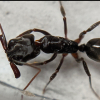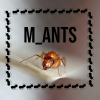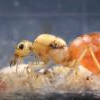- Formiculture.com
- Forums
- Gallery
- Members
- Member Map
- Chat

33 replies to this topic
#21
 Offline
-
Posted October 8 2018 - 5:39 PM
Offline
-
Posted October 8 2018 - 5:39 PM
I wanted to put the firebrick I'm the tank to save horizontal space and because I’m worried the tetramorium would gnaw right through it. That would end my nascent hobby and perhaps my marriage as well.
"The ants are a people not strong, yet they prepare their meat in the summer." Prov. 30:25
Keep ordinary ants in extraordinary ways.
Keep ordinary ants in extraordinary ways.
#22
 Offline
-
Posted October 8 2018 - 5:54 PM
Offline
-
Posted October 8 2018 - 5:54 PM
Lol I know that feeling, still need to have "that talk" with my GF.I wanted to put the firebrick I'm the tank to save horizontal space and because I’m worried the tetramorium would gnaw right through it. That would end my nascent hobby and perhaps my marriage as well.
I mean that would suck to have to trash what you have. Maybe putting them in a more appropriate setup and "upgrade" when they are larger?
As far as sealing goes. I saw a video from ants Australia where he sealed nests with clay. So maybe you could add like two small nests and one big one and seal with clay and remove it as they are ready to expand?
But Nurbs is right let's not go on too many tangents. We can make a new thread about this very subject
Edited by Kalidas, October 8 2018 - 6:03 PM.
#23
 Offline
-
Posted October 8 2018 - 7:42 PM
Offline
-
Posted October 8 2018 - 7:42 PM
Thank you, Nurbs! I really appreciate your feedback, but dang now what am I going to do? I’m leaning heavily now just towards filling the tank halfway up with dirt and letting my pavement ants nest under a flat rock. They will love it. I have two colonies, so one can go in dirt and maybe I can save up for THA formicarium for the other. I have one in a tub and tube set up and the other is exploding out of a mini-hearth (that’s the one I really need to move.)
I wanted to put the firebrick I'm the tank to save horizontal space and because I’m worried the tetramorium would gnaw right through it. That would end my nascent hobby and perhaps my marriage as well.
How large are your colonies? And how large is that image of the firebrick you posted? It looks big, but the pic could just be misleading.
For me - and this is my personal opinion - the fun of antkeeping is being able to OBSERVE the ants in all aspects of their daily life and routine. Putting them in a fancy setup terrarium with plants and moss and water like AC or under a rock or like many of the videos on YouTube defeats this purpose. If you cannot locate your queen within the first 30 seconds of looking at your nest, that is not good. If the ants are mostly hidden, it also makes ascertaining the health of the colony difficult. Is the queen alive? Is she laying eggs? Is the brood developing? Not to mention the maintenance and the amount of bacteria and fungus that can germinate in such a setup, regardless of how many springtails and scavengers you have.
Stick with the test tube in a bin setup. Add more test tubes as the colony grows. Replace dirty test tubes. I know that sounds stupidly simple, but it works.
If you've already spent a lot of time carving out the chambers, which looks nice, just find some way to attach them non-permanentely? But I promise you within the first few weeks the ants will start putting food particles in the nest, especially if the colony is small, and you are going to see mold if there is moisture and heat.
Instagram:
nurbsants
YouTube
California Ants for Sale
Unidentified Myrmecocystus
https://www.formicul...ls-near-desert/
Undescribed "Modoc"
https://www.formicul...mp-ca-5-4-2017/
Camponotus or Colobopsis yogi:
https://www.formicul...a-ca-1-28-2018/
Camponotus us-ca02
https://www.formicul...onotus-us-ca02/
Unidentified Formica
https://www.formicul...l-ca-6-27-2020/
Pencil Case and Test Tube Formicariums
https://www.formicul...m-and-outworld/
Bloodworm Soup
https://www.formicul...bloodworm-soup/
#24
 Offline
-
Posted October 8 2018 - 8:21 PM
Offline
-
Posted October 8 2018 - 8:21 PM
ANTdrew,
That's a good looking formicarium. Here are some questions for you.
Where is the access into the nest? I assume there's a hole in the back of the firebrick blocks that the picture does not show? How is the snap-cap bottle fit into place? Are you able to access it without squishing ants? How's the ventilation looking at the top? That's gonna be the main determinant of how well the whole system will hold onto moisture; temperatures above 90° F may overtake ventilation in this regard. What is the plan for the rest of the nest? Adding dirt? It's a bit late now, but you could have almost created a water pool at the bottom, laid a floor of firebrick (wedged about 3/8" above the bottom), and have that be your water tank. Refilling the tank is as easy as adding water through a tube or pouring water near a corner where ants are not congregated to allow it to seep into the reservoir. Heating the bottom will increase evaporation rate. Ventilation and temperature ought to be adjusted in response to how the ants behave.
Also the clear gloss spray is designed to be sprayed over existing paint. I doubt it will adhere effectively to plain firebrick since it's not even a paint. I'm sorry I can't be more helpful in this regard, I don't have much experience in sealing firebrick. This is really a niche knowledge that only ant keepers would ever need to know. I have to go now but we can continue this conversation tomorrow.
nurbs,
I see you saw me writing a reply and quickly posted yours before I could mine. Sneaky. Anyways, thanks for chiming in, second opinions are always helpful. I seem to scare away people who have second opinions so I'll try to be more careful with this response. It's never my intention to silence anyone, so...
You can clean the nest when it's sealed. He's applying a coat(s) of liquid rubber on the outside of the firebrick blocks. The piece itself is still able to be removed to be cleaned. Correct me if I'm wrong - he's not gluing the piece to the acrylic box (which would prevent maintenance). The liquid rubber is a waterproof barrier and ants are not penetrating that, or the firebrick. If you need to clean the piece, you can simply take it out and clean it, including the surface that's been treated with the liquid rubber.
The firebrick block is also reusable unless the mold is going to penetrate inside the pores. In that case, you can douse it with hydrogen peroxide, let it sit for 10 minutes, then rinse it out thoroughly with a garden hose. I use hydrogen peroxide (3%, which is cheap and commonly sold at all pharmacies/supermarkets in the U.S.) to clean my test tubes and the ants are not affected in any way. Hydrogen peroxide will kill mold, but it's important you rinse out the dead mold because they actually continue to send out spores even if dead. Also to get rid of the 3% hydrogen peroxide that WILL kill bacteria, mold, ants, etc. It is water soluble so spraying with a garden hose is more than enough to get rid of the trace amounts. I cleaned mine in a sink and there were no problems. The brick is definitely reusable unless I am missing some crucial information. Please enlighten me if that's the case.
ANTdrew specified in an earlier post that the tank it's going in is 10" x 10". Not the smallest container, but not too large. The larger piece looks to be about 10" x 3" x 2".
I like the idea of multiple test tubes in a container immensely - simplicity is result of smarter work, not due to any lack of intelligence. Here's a question for you: It is not practical to keep species of ants that have large colonies by the tens or hundreds of thousands in multiple test tubes. Have you or Drew ever been able to figure out some sort of design concept that could be expanded and scaled properly? We're talking in terms of heating, hydration, maintenance, etc. I understand that the multiple test tube method is one of the best for rearing a variety of founding colonies, but what about afterwards once the colony reaches thousands of workers? I also understand that ants are most fun to keep in the beginning stages of colony life, but surely there must be some tips for people who are thinking long term (10+ years, or however long it takes for the queen to die). Any insight?
#25
 Offline
-
Posted October 8 2018 - 9:08 PM
Offline
-
Posted October 8 2018 - 9:08 PM
I'm referring to the ability to clean the nest while there is a colony living in it. How would you remove a molding cricket inside the nest while there are hundreds of workers?
When you say liquid rubber, are you referring to rubber cement? I use that for work, but not for ants. Rubber cement is very high in VOC, and I believe it contains butane. The fumes are very strong, but could be harmless after it dries.
Most novice antkeepers are working to get their colony past the first year. The problems rearing a colony of 10 workers is different from a colony of 1000. Address the problem with rearing a young colony first. If you can't figure out how to remove a moldy cricket inside the nest with 10 workers, it won't get to a hundred, much less a thousand.
Here is a colony I sold to Stemworld, a child's science center and museum in Pasadena. Depending on the species, it is extremely practical to keep a mature colony in test tubes. This video was shot when it was two years old, about 1500 workers. I sold it when it hit about 2000-3000 workers earlier this year.
I transferred the colony to a custom Tar Heel Ants Pioneer for display, handmade to my specifications. Here it is on the day I gave it to them. The nest is easily expandable. I do have videos of the transfer, it's just not posted yet.


You can clean the nest when it's sealed. He's applying a coat(s) of liquid rubber on the outside of the firebrick blocks. The piece itself is still able to be removed to be cleaned. Correct me if I'm wrong - he's not gluing the piece to the acrylic box (which would prevent maintenance). The liquid rubber is a waterproof barrier and ants are not penetrating that, or the firebrick. If you need to clean the piece, you can simply take it out and clean it, including the surface that's been treated with the liquid rubber.
The firebrick block is also reusable unless the mold is going to penetrate inside the pores. In that case, you can douse it with hydrogen peroxide, let it sit for 10 minutes, then rinse it out thoroughly with a garden hose. I use hydrogen peroxide (3%, which is cheap and commonly sold at all pharmacies/supermarkets in the U.S.) to clean my test tubes and the ants are not affected in any way. Hydrogen peroxide will kill mold, but it's important you rinse out the dead mold because they actually continue to send out spores even if dead. Also to get rid of the 3% hydrogen peroxide that WILL kill bacteria, mold, ants, etc. It is water soluble so spraying with a garden hose is more than enough to get rid of the trace amounts. I cleaned mine in a sink and there were no problems. The brick is definitely reusable unless I am missing some crucial information. Please enlighten me if that's the case.
ANTdrew specified in an earlier post that the tank it's going in is 10" x 10". Not the smallest container, but not too large. The larger piece looks to be about 10" x 3" x 2".
I like the idea of multiple test tubes in a container immensely - simplicity is result of smarter work, not due to any lack of intelligence. Here's a question for you: It is not practical to keep species of ants that have large colonies by the tens or hundreds of thousands in multiple test tubes. Have you or Drew ever been able to figure out some sort of design concept that could be expanded and scaled properly? We're talking in terms of heating, hydration, maintenance, etc. I understand that the multiple test tube method is one of the best for rearing a variety of founding colonies, but what about afterwards once the colony reaches thousands of workers? I also understand that ants are most fun to keep in the beginning stages of colony life, but surely there must be some tips for people who are thinking long term (10+ years, or however long it takes for the queen to die). Any insight?
Edited by nurbs, October 8 2018 - 11:31 PM.
Instagram:
nurbsants
YouTube
California Ants for Sale
Unidentified Myrmecocystus
https://www.formicul...ls-near-desert/
Undescribed "Modoc"
https://www.formicul...mp-ca-5-4-2017/
Camponotus or Colobopsis yogi:
https://www.formicul...a-ca-1-28-2018/
Camponotus us-ca02
https://www.formicul...onotus-us-ca02/
Unidentified Formica
https://www.formicul...l-ca-6-27-2020/
Pencil Case and Test Tube Formicariums
https://www.formicul...m-and-outworld/
Bloodworm Soup
https://www.formicul...bloodworm-soup/
#26
 Offline
-
Posted October 9 2018 - 5:23 AM
Offline
-
Posted October 9 2018 - 5:23 AM
Well, I'm pretty discouraged. To answer some of your questions, the tetramorium immigrans colony is really exploding in numbers. I can't get an accurate count even, but I guess they are well over a hundred. Workers and brood are covering the entire cave area of the mini-hearth they are in. Even the queen was hanging from the ceiling last night when I peaked in on her. There is a half inch tall mountain of brood taking up most of the floor of the mini-hearth as well. New ants eclose daily. I'm tired of not being able to clean or do anything in their foraging area without ants running up the sides trying to get out. I keep them in a warm kitchen (steady 82degrees) and feed them lots of fresh insects, so they are thriving.
I drilled two access holes to the nest in the back of the firebrick block. I made a water tower by drilling out a hole big enough for a snap cap vial to fit in and hot gluing it in place. I can fill this vial from a hole in the top of the brick, which I will plug up with a rubber stopper.
I guess at this point I will just try to move them out of the mini-hearth into more test tubes placed in my 10"x10" tank.
"The ants are a people not strong, yet they prepare their meat in the summer." Prov. 30:25
Keep ordinary ants in extraordinary ways.
Keep ordinary ants in extraordinary ways.
#27
 Offline
-
Posted October 9 2018 - 2:23 PM
Offline
-
Posted October 9 2018 - 2:23 PM
I pitched the bricks. Back to the drawing board, I guess.
"The ants are a people not strong, yet they prepare their meat in the summer." Prov. 30:25
Keep ordinary ants in extraordinary ways.
Keep ordinary ants in extraordinary ways.
#28
 Offline
-
Posted October 9 2018 - 4:06 PM
Offline
-
Posted October 9 2018 - 4:06 PM
Just get some test tube setups in a bin. Lay hydrostone on the bin so the test tubes don't roll around. Easy to maintain, easy to clean, easy to feed.
Instagram:
nurbsants
YouTube
California Ants for Sale
Unidentified Myrmecocystus
https://www.formicul...ls-near-desert/
Undescribed "Modoc"
https://www.formicul...mp-ca-5-4-2017/
Camponotus or Colobopsis yogi:
https://www.formicul...a-ca-1-28-2018/
Camponotus us-ca02
https://www.formicul...onotus-us-ca02/
Unidentified Formica
https://www.formicul...l-ca-6-27-2020/
Pencil Case and Test Tube Formicariums
https://www.formicul...m-and-outworld/
Bloodworm Soup
https://www.formicul...bloodworm-soup/
#29
 Offline
-
Posted October 9 2018 - 4:30 PM
Offline
-
Posted October 9 2018 - 4:30 PM
ANTdrew,
I'm sorry your original idea didn't meet your standards. Everyone here wants their ants to flourish and no one can fault you for refusing to introduce your ants to an untested setup. I have 8 surviving Tetramorium colonies as well and the heated colonies are at over 200 workers in less than 100 days. Half of those ants eclosed the past 2 weeks since I introduced them to the peanut butter setup. Those workers were going to come out anyway so the peanut butter formicarium didn't influence that. It probably made no difference since these ants will nest anywhere there's 99% RH and heat. In contrast, the ones kept slightly colder than room temperature only have 16-26 workers after 100 days. I am not hibernating them so we can expect the exponential growth to continue. Probably 5,000 workers for each colony this time next year.
I'll make a thread soon for some hardcore brainstorming where we will break down formicarium design to a strict science; hopefully you will find that thread informational/inspirational. nurbs should join in the discussion. I hope drtrmiller is still around too.
nurbs,
Cleaning a nest while the colony is living in it without disturbing them is a hard criteria to meet. You would have to include detachable housing units (e.g. test tubes) that a tweezer could easily fit through. You are not wrong; however, that standard also discredits the custom THA Pioneer nest since you would have to remove the entire cover to take out a cricket. I can see the importance of your statement and it'll be an interesting challenge to tackle.
Regarding the liquid cement, no that's not the same product we are talking about. Please read the discussion ANTdrew and I were having in this thread. The liquid rubber was a potential solution to the problem of firebrick "breathing" too much and not being able to hold in moisture for long periods of time without requiring maintenance in a setup with proper ventilation.
I really can't disagree with your perspective about getting past the first 1-10 generations. In a perfectly logical world with patient ant keepers, everyone would do as you do. But people want to experiment. Humans are highly individualistic and it shows in our choices of clothing, hobbies and even books. Custom formicaria is no exception. In this regard, conservative ant keepers would refer back to tried and true methods as you have done, while others would try for less conventional solutions in an effort to make it work. More than 9 times out of 10, the latter will fail. However, the rare case when it works is how progress is made. The creative tension caused by both conflicting perspectives makes for excellent breeding grounds for innovation. I believe this aspect of ant-keeping, due to it being a rather niche hobby and an understudied topic in academia, is what makes it mysterious and exciting for most of us.
Were you ever able to establish a population cap for any of the species you have kept? Growth rate is one thing, but knowing the true limits of a particular species of ant is another. Especially since the correlation between the growth rate/population limit of ants and the "more favorable" captive environments and the "less favorable" wild environment is not clear. What if limited nesting area is causing the ants to limit production? In the wild, ants can make their nests as large as they want to. The same cannot be said for man-made nests. I'm just musing at this point, you're right about making sure the type of nest you choose fits the intended application. In this case, ANTdrew is keeping Tetramorium and judging from the growth rate of my heated colonies, they will fill 4 test tubes once they are 6 months old. They grow fast.
#30
 Offline
-
Posted October 9 2018 - 5:23 PM
Offline
-
Posted October 9 2018 - 5:23 PM
The THA Pioneer has never had a moldy insect because I made sure size of the colony correlates with the size of the nest. I come into the science center and check every month. That's why I said many new antkeepers spend all a lot of time making these large formicariums, yet they may not even know what species of ants they are keeping, or only have a colony with 10 workers. Again, deal the the problems of a small colony first before you try and come up with solutions to a larger colony.
There's no "creative tension" with people experimenting. I don't have a problem if it's a new idea, that's great. But if you are trying out something that many others have already tried, they are going to tell you it won't work. I haven't seen any new ideas on here, just people making a variation of what they see on YouTube or copying a commercial maker.
Understand the needs of the ants first, not the process or the materials. It doesn't matter how much of a material expert you are, if you do not understand the requirements of a certain species, the nest will fail. Form must follow function.
nurbs,
Cleaning a nest while the colony is living in it without disturbing them is a hard criteria to meet. You would have to include detachable housing units (e.g. test tubes) that a tweezer could easily fit through. You are not wrong; however, that standard also discredits the custom THA Pioneer nest since you would have to remove the entire cover to take out a cricket. I can see the importance of your statement and it'll be an interesting challenge to tackle.
Regarding the liquid cement, no that's not the same product we are talking about. Please read the discussion ANTdrew and I were having in this thread. The liquid rubber was a potential solution to the problem of firebrick "breathing" too much and not being able to hold in moisture for long periods of time without requiring maintenance in a setup with proper ventilation.
I really can't disagree with your perspective about getting past the first 1-10 generations. In a perfectly logical world with patient ant keepers, everyone would do as you do. But people want to experiment. Humans are highly individualistic and it shows in our choices of clothing, hobbies and even books. Custom formicaria is no exception. In this regard, conservative ant keepers would refer back to tried and true methods as you have done, while others would try for less conventional solutions in an effort to make it work. More than 9 times out of 10, the latter will fail. However, the rare case when it works is how progress is made. The creative tension caused by both conflicting perspectives makes for excellent breeding grounds for innovation. I believe this aspect of ant-keeping, due to it being a rather niche hobby and an understudied topic in academia, is what makes it mysterious and exciting for most of us.
Were you ever able to establish a population cap for any of the species you have kept? Growth rate is one thing, but knowing the true limits of a particular species of ant is another. Especially since the correlation between the growth rate/population limit of ants and the "more favorable" captive environments and the "less favorable" wild environment is not clear. What if limited nesting area is causing the ants to limit production? In the wild, ants can make their nests as large as they want to. The same cannot be said for man-made nests. I'm just musing at this point, you're right about making sure the type of nest you choose fits the intended application. In this case, ANTdrew is keeping Tetramorium and judging from the growth rate of my heated colonies, they will fill 4 test tubes once they are 6 months old. They grow fast.
Instagram:
nurbsants
YouTube
California Ants for Sale
Unidentified Myrmecocystus
https://www.formicul...ls-near-desert/
Undescribed "Modoc"
https://www.formicul...mp-ca-5-4-2017/
Camponotus or Colobopsis yogi:
https://www.formicul...a-ca-1-28-2018/
Camponotus us-ca02
https://www.formicul...onotus-us-ca02/
Unidentified Formica
https://www.formicul...l-ca-6-27-2020/
Pencil Case and Test Tube Formicariums
https://www.formicul...m-and-outworld/
Bloodworm Soup
https://www.formicul...bloodworm-soup/
#31
 Offline
-
Posted October 9 2018 - 5:31 PM
Offline
-
Posted October 9 2018 - 5:31 PM
So the issue of moldy bugs and garbage goes away with just proper sizing? That's a relief.
#32
 Offline
-
Posted October 9 2018 - 5:41 PM
Offline
-
Posted October 9 2018 - 5:41 PM
It doesn't 100% go away, but yes, much better. As an antkeeper you are always going to have to deal with issues of mold.
On a THA formicarium, if there is mold in a certain spot that looks bad, I put the nest in the fridge for 15 minutes to slow down the ants. Then I open up the glass and use a tweezer to take out anything nasty.
THA nests have a removable front via magnets, and in most cases you can ever so gently slide it horizontally on either direction to remove bits of uneaten food. I rarely do this because I make sure the colony is not too small for the nest.

So the issue of moldy bugs and garbage goes away with just proper sizing? That's a relief.
Instagram:
nurbsants
YouTube
California Ants for Sale
Unidentified Myrmecocystus
https://www.formicul...ls-near-desert/
Undescribed "Modoc"
https://www.formicul...mp-ca-5-4-2017/
Camponotus or Colobopsis yogi:
https://www.formicul...a-ca-1-28-2018/
Camponotus us-ca02
https://www.formicul...onotus-us-ca02/
Unidentified Formica
https://www.formicul...l-ca-6-27-2020/
Pencil Case and Test Tube Formicariums
https://www.formicul...m-and-outworld/
Bloodworm Soup
https://www.formicul...bloodworm-soup/
#33
 Offline
-
Posted October 9 2018 - 5:51 PM
Offline
-
Posted October 9 2018 - 5:51 PM
Oh nice, those formicariums sound great.
But yeah I think you make some very compelling arguments for test tube setup, esspecialy for small colonies. The health and safety of the ants should be the number 1 concern for any keeper
But yeah I think you make some very compelling arguments for test tube setup, esspecialy for small colonies. The health and safety of the ants should be the number 1 concern for any keeper
#34
 Offline
-
Posted October 9 2018 - 8:34 PM
Offline
-
Posted October 9 2018 - 8:34 PM
nurbs,
Thanks for taking the time to respond. All good info, I've made you repeat yourself twice now. Am I correct in assuming your answer to my question of population cap is that it's not a question worth asking until the colony is large enough? The species in question for this thread has already been established as Tetramorium immigrans. This species will outgrow multiple test tubes and THA formicaria under $300 within a year if kept at 90° F/99% RH and fed adequately. Waving away the issue by saying I must understand the requirements of certain species of ants before providing any advice ignores two things: 1. It has been established the species in question is Tetramorium immigrans, and 2. There was a forum member asking for ideas, which I have provided.
It'd be nice if we could get some species-specific advice then since the request has been identified already, instead of notifying us that we don't know enough so that's that. People who keep Tetramorium are surprised by their growth speed and are often left scrambling to get a nest big enough to accommodate the colony for at least 3 more months, during which time the colony will triple in size, initiating another move. I saw some threads on this forum with people who keep large Tetramorium colonies - the nests are always dirty, unnecessarily large and [looks] difficult to maintain. Without potentially stunting the growth rate of the colony by not providing enough space, how do you propose that we deal with this in the future? It's one thing to be practical in the present, it's quite another to dismiss future concerns entirely.
I have had colonies not bat an eyelid at 3 months+ moldy test tube. Correct me if the mold species that grow on insects are more lethal to ants than the mold species that grow on ant waste on a cotton ball. After this time, the colony will need another move to a larger formicarium anyway. So either way, this discussion boils down to this: If you've never had a moldy insect in a formicarium because the colony is large enough to inhabit all areas of the nest, isn't it time to move them to a larger formicarium so they can continue to grow? All formicaria have a maximum capacity, at which point nature will take it upon herself to regulate population.
Depending on your definition, there hasn't been a new idea since 200 BC. This one we should drop.
Also tagged with one or more of these keywords: formicarium
 |
Ant Keeping →
Ant Keeping Journals →
The_Gaming-gate's Ant Nest DesignStarted by The_Gaming-gate , Apr 4 2024 |
|

|
|
 |
Ants & Myrmecology →
General →
PlasterStarted by The_Gaming-gate , Apr 3 2024 |
|

|
|
Ant Keeping →
General Ant Keeping →
Formicarium concept: slip casting potteryStarted by Nixionika , Mar 5 2024 |
|

|
||
Formiculture.com →
Member Introductions →
Introducing: AntCondo™Started by AntCondo , Jan 5 2024 |
|

|
||
Ant Keeping →
General Ant Keeping →
NEW leaf cutter formicarium!Started by FinWins , Sep 4 2023 |
|

|
0 user(s) are reading this topic
0 members, 0 guests, 0 anonymous users















